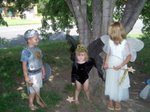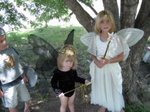Little Joe said...
I'll admit to bringing the New Year's Cookies to the ethnic meal. In case anyone is interested in knowing how I make them, here is the recipe:

New Year’s Cookies
(Raisin Fritters)
“Niejoasch Küake” or “Portselkje”
2 C. raisins (plumped)
½ C. sweet cream
¼ C. butter
2 eggs (beaten)
½ t. vanilla
1 C. potato water
1 T. sugar
2 T. active dry yeast
3 C. flour (plus about 1 C. extra flour, the amount will depend on the size of eggs and humidity on the day you are making these fritters)
¼ C. sugar
2 t. salt
1 t. baking powder
½ t. nutmeg
sugar for coating
Plump raisins by pouring boiling water over them and allow to soften for 10-15 minutes; drain. Scald cream; add butter and cool to lukewarm; add beaten eggs and vanilla. Dissolve 1 T. sugar in warm potato water and add yeast to activate. Sift 3 C. flour and the other dry ingredients together. Place cream mixture, yeast mixture and dry ingredients in a mixing bowl and stir to combine. Finish by kneading in the extra flour and raisins to make a soft dough. (If using a bread machine, place cream mixture, dry mixture and yeast mixture in bread pan and allow to mix on the dough cycle, adding additional flour until the dough pulls away from the sides of the pan. When the machine mixing has ended, carefully add raisins and mix thoroughly throughout the dough—otherwise the mixing paddle will beat the raisins to pieces. It works best to take the dough out of the pan and knead the raisins in by hand. One can also do this in the bread machine pan using a rubber spatula. Mixing a small amount of flour with the raisins will help keep them in the dough so they won’t fall out.) Allow to rise until double in bulk. Pinch off small balls of dough and place on baking sheet. When they have raised again fry in deep, hot fat until golden brown (about 2—3 minutes per side). Some recipes call for less flour, resulting in a batter rather than dough. After the batter has raised, it is dropped by spoonfuls into the hot fat with the result being a football-shaped pastry. Remove fritters from hot fat and cool. Before serving, place several fritters at a time in a sack with sugar and shake to coat evenly.
The cultural connection:
Dutch Mennonites moving to the Vistula River delta (in present day Poland) in the 16th century most likely brought with them a tradition of serving fried cakes or fritters on New Year’s Day. The Dutch version was called Oliebollen (oh-lee-bow-len) or Oliekoeks (literally oil balls or oil cakes) because they were fried in oil. Cakes and pastries fried in deep fat are still eaten in some northern European countries to celebrate the New Year. They are a symbol of affluence and luxury. Fried pastries carried with them the wish for a prosperous, fat (abundant) New Year.
The Low German speaking Mennonites carried the tradition to Russia in the late 18th and early 19th centuries. In Low German they are called Portselkje (port-zell-kya). When the spongy yeast batter or dough is dropped by spoonsful into hot, deep fat, the dough puffs up, tumbles over and fries to a golden brown. “Portsel” in Low German means tumbling over. Hence the name, “Portselkje”.
The ingredients of New Year’s Cookies are symbolic of a prosperous and happy New Year:
Flour & potato water = the necessities of life
Cream, butter and frying oil = abundance, luxury
Sugar = sweetness
Eggs = reproduction, prosperity
Yeast & baking powder = growthSalt = a preserving and savoring quality
Vanilla & nutmeg = a flavorful and spicy life
Raisins = fruitfulness
The recipe is from my Mama.
Cultural connection/history from “Mennonite Foods & Folkways from South Russia, volume 1” by Norma (Jost) Voth.













10 comments:
Wow! These sound fabulous!! Sheesh, and just after I started my diet... lol
(Love the commentaries on the ingredients, too... what a great recipe!)
Which is why I had to pull this recipe out of my comments and feature it in a blog post of it's own. (...because of the commentaries, not because of your diet. lol)
When one of my nephews was first married, his wife was enthralled with family history, genealogy and all the cultural connections we of Low German descent take for granted. When she disovered a recipe for New Year's cookies, she insisted they make some right away. My nephew (along with my brother-in-law who is a character in his own right) convinced her that New Year's cookies could only be made on New Year's Day.
New Year's cookies are made and sold at the Kansas MCC relief auction in Hutchinson each April. My cousin also makes and sells them at the Hillsboro (KS) Arts & Crafts Fair each September.
I just thought of several others comments for anyone trying to make these. If you're a novice at cooking, like I was when I started about 10 years ago, you may be wondering "What is potato water?" That is the leftover water from boiling peeled potatoes. Mama never poured it down the drain; she saved it for use in baking yeast breads. I suppose the starch in the water feeds the yeast. You could get the same results by adding 1 or 2 teaspoons of instant mashed potato flakes to plain water. One the other hand, the sugar will also feed the yeast, but most of Mama's recipe's that use yeast also call for potato water.
The baking powder seems to prevent the fritters from absorbing too much grease. That's why the recipe calls for both yeast and BP.
I have trouble getting my hot fat to the right temperature. Too hot, and they get too brown. Too cool, and they absorb too much grease despite the comment in the previous paragraph. Just right, and they are fabulous.
I have to help them tumble over, and then sometimes they don't want to stay turned over. So I try to hold them in place with a slotted spoon. For that reason, it helps not to have too many in the fryer at one time.
Thanks, little joe, for the additional info. I'd be glad to post other recipes with commentaries from time to time if you would want to compose them.
Hi! I wish I was there, as I'd eat the lot then go for a jog!
Thought you might like the taste of Aussie scones so here's the link:
http://www.taste.com.au/recipes/8163/basic+scones
Take Care!
Peter
Thanks for the link, Peter! I wondered what scones were, just never looked them up. They appear to be pretty much the same as what our biscuits are. We've got lots of variations on the basic biscuit, here's one...
http://www.cookingforengineers.com/recipe/41/Basic-Biscuits
Hi! Looked it up and again, sounds pretty good! For a true Aussie recipe you can't go past a "damper".
3 cups of Self Raising Flour; 2 teaspoons Salt; 1 cup Water.
Throw it all together and place on foil, on top of hot coals placed in the ground. Throw hot coals on top of that and cook for 30 mins. Then you'll have old fashioned Aussie Damper - that is - Bread.
Regards,
Peter
LOL! I don't know how truely Aussie breads can be, you may have to go to something fixed with ingredients native to Australia. Flour with something to make it rise and then salt and liquid added is a universal bread mix. Check out the recipe for the Native American bread, Bannock...
http://www.best-bread-recipes.com/bannock-recipe.html
I wonder if you can toss your foil wrapped damper in a fire pit and get the same result as coals?
Post a Comment